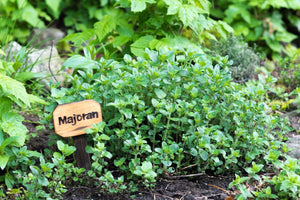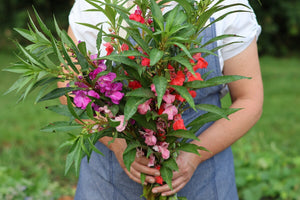Boost Your Garden's Charm with Native Coreopsis Flowers
CoreopsisYou've likely seen native Coreopsis or Lanceleaf Tickseed growing in fields and along roadways. This bright flower is easy to grow and low maintenance. We'll give you helpful tips for growing coreopsis, from seed germination to cutting blooms for indoor enjoyment.

The sunny yellow perennial known as Dwarf Lance-Leaved Coreopsis, or Lanceleaf Tickseed, is a versatile and resilient plant. It thrives in various light conditions, including full sun, part shade, and shade, making it adaptable to different garden environments. Once planted, this hardy perennial will grace your garden year after year.
Dwarf Lance Leaved Coreopsis is particularly well-suited for gardens in hot, dry climates due to its low-maintenance nature and drought tolerance. Typically reaching a height of 1-2 feet, this plant has a spreading, clump-forming habit, adding a beautiful, natural touch to any garden.
One of the outstanding features of coreopsis is its attractiveness to pollinators. Butterflies, bees, and other beneficial insects are drawn to its blooms, which provide a continuous source of nectar and pollen from late spring to early fall. This long blooming period makes it an essential food source for these crucial pollinators. In addition, the nectar in the flowers appeals to butterflies and bees, while the seeds are a favorite among birds.
For anyone looking to create a vibrant butterfly or pollinator garden, Dwarf Lance-Leaved Coreopsis is a definite must-have. It adds both color and ecological value to the garden space.
How to Grow Coreopsis from Seed
Lance leaf coreopsis flowers can be grown from seeds started indoors or directly sown. Some simple requirements will ensure your seed starting success.
Coreopsis seeds can be sown in late fall along with other wildflowers. The winter weather will naturally cold stratify them, and the seeds will sprout when the ground warms up in spring.
You can also start coreopsis flowers indoors 4-6 weeks before transplanting outdoors.

Tips for fail-proof Coreopsis seed germination
- Cold stratify coreopsis seeds for 2-4 weeks before planting in spring.
Gently press seeds into the soil and mist them with water.
Coreopsis seeds need light to germinate. If starting seeds indoors, place them under grow lights.
Keep seeds moist until germination.
Soil temperature between 65-70ºF is optimal.
Using a humidity dome indoors can help the seeds stay moist.
Seeds can take 14 to 18 days to germinate.

How to Grow and Maintain Coreopsis Plants
The beauty of growing native flowers is that they aren’t high maintenance. Coreopsis flowers will grow in all kinds of conditions. Lanceleaf coreopsis will grow 12 to 18 inches tall and flower from late spring into fall.
Coreopsis seedlings that have been started indoors will need to hardened off before transplanting outdoors. Make sure all danger of frost has passed before transplanting or starting seeds outdoors.
Sun
Coreopsis can grow in full sun to shade. Daily direct sun over 6 hours will result in more blooms.
Soil
Naturalized coreopsis plants grow in a variety of soils. In your home landscape, make sure you have well-draining soil. Well-established plants prefer dry soil and may droop in overly moist or rich soils.
Water
Coreopsis is drought-tolerant and thrives in hot, dry conditions. Seedlings and young plants need consistent water until they have a strong root system. Once they are established, coreopis plants don’t need a lot of water. Too little water can result in fewer blooms.
Fertilizing
These native wildflowers don’t need extra fertilizer. For perennial Lance Leaf coreopsis, add a layer of compost each spring.
Deadheading
Deadheading coreopsis flowers will encourage them to keep blooming all summer. Cutting off spent flowers before they go to seed will also prevent coreopsis from self-seeding.

Pests and Diseases
One reason to grow coreopsis is that it is disease—and pest-resistant. It is even resistant to the devastating Japanese beetles. Lance leaf coreopsis is deer-resistant.
Slugs and snails can be a problem in moist areas and powdery mildew.
Harvesting Coreopsis Flowers
Coreopsis can be grown and cut for flower arrangements. Cut coreopsis flowers in the morning when the stems are the most erect. Immediately place in water. Once cut, coreopsis flowers can last seven days in a vase.

Coreopsis FAQs
Does coreopsis come back every year?
There are annual varieties of coreopsis plants. Lance Leaf Coreopsis is a perennial flower that comes back each spring. After a few years, it will need to be reseeded. However, you can allow the blossoms to go to seed, and the plant will take care of reseeding itself.
Does coreopsis spread?
Coreopsis can spread through underground rhizomes and self-seeding. Plants can be dug up to control spreading. To prevent self-sowing, spent flowers should be removed before they go to seed.
Coreopsis is a beautiful wildflower that can easily be grown in all kinds of soil. It will fill your landscape with bright flowers that attract butterflies and beneficial insects. This low-maintenance flower is just what you need in a pollinator or butterfly garden.
Popular Posts
-

Learn How to Grow Marjoram - The Secret Ingredient Herb
-

Balsam: How to Grow Impatiens Balsamina Flowers from Seed






Leave a comment